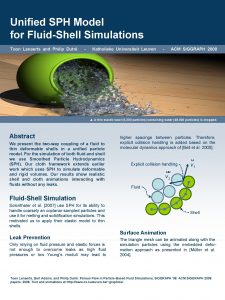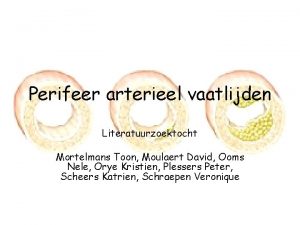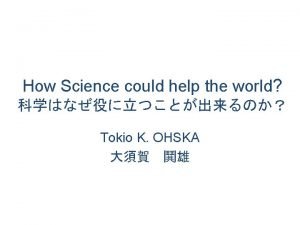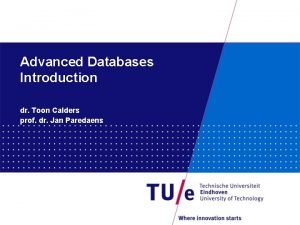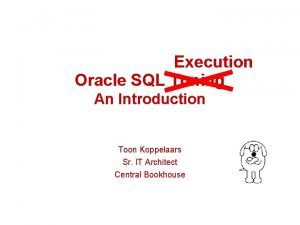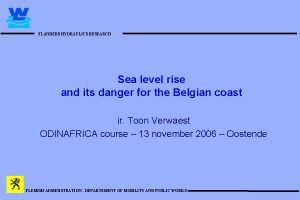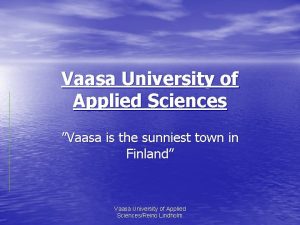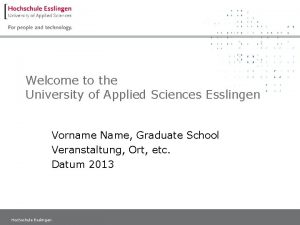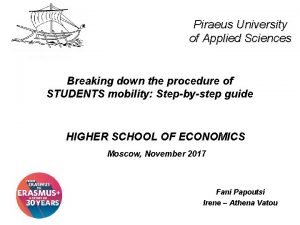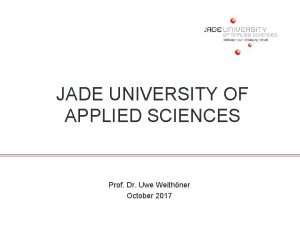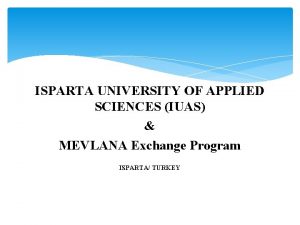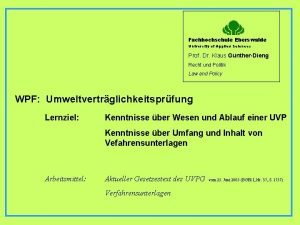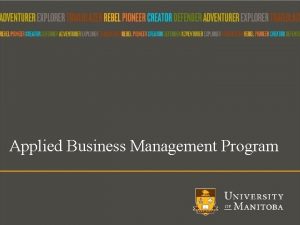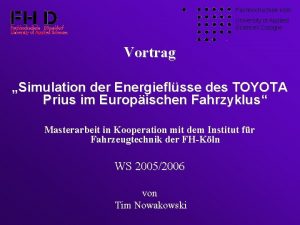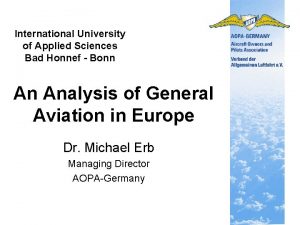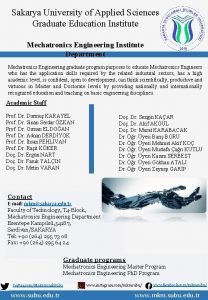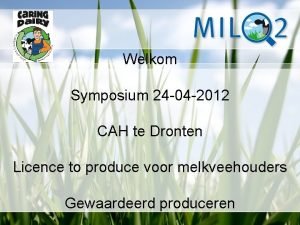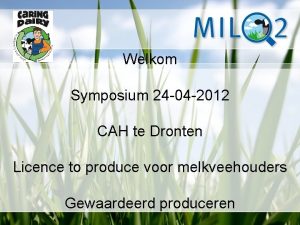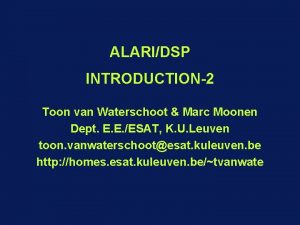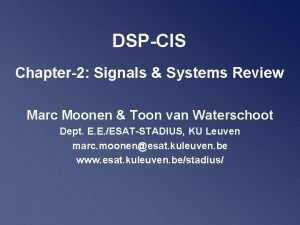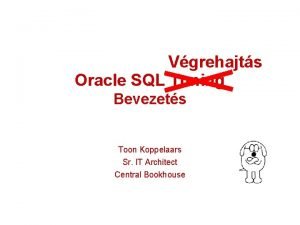Ir Toon van Aert Dronten University of Applied

































- Slides: 33

Ir. Toon van Aert Dronten University of Applied Sciences

Course Description LLP ERASMUS INTENSIVE PROGRAMME Organic Agriculture-Innovation for a Sustainable Agriculture, Food Safety and Public Health Program Tuesday morning May 26 (Mr. Toon van Aert) Introduction Dronten University of Applied Sciences. The safety of organc food: is there anything special? ◦ Lesson 1: basics of food safety ◦ Lesson 2: what is special about safety of organic food?


Dronten University of Applied Sciences § § 1200 students (150 international) 80 academic staff 7 Internat. degree courses (one year-programme) Title: “Ingenieur” Equivalent Bachelor Honours degree

Dronten University of Applied Sciences University buildings Business Centre International campus

Results until 2008 Graduates Start 1997 Graduated 1300 About 30 nationalities

Nationalities Canada Czech Republic Cyprus Ethiopia France Hungary India Italy Kyrgyzstan Latvia Nigeria Poland Portugal Romania Slovakia South Africa Spain Tanzania Turkey Uganda Ukraine USA Vietnam

Highly skilled graduates From home university: strong scientific orientation At DUAS Dronten: high attention for professional skills and intercultural management During placement: professional practice extremely important

International courses DUAS International BSc programs: European Funds Management International Food Chain Management International Rural Innovation and Development International Livestock Production International Food Safety Management International Animal Health and Welfare International Horticultural Management

International Food Safety Management Contents: Food Chain Management Setting up & maintaining Q-system Auditing Q-systems Implementing improvement processes EU-institutions & international food legislation International management / financial management Communication, reporting & intercultural aspects Examples of functions: Quality assurance / food safety manager Food safety auditor & consultant

Basics of Food Safety Toon van Aert Olga Kujawska

Let’s look: myths about unsafe/safe food

Your opinion about organic food The safety of organc food: is there anything special? What do you think: ◦ More safe ? ? ? ◦ Less safe ? ? ? ◦ No difference ? ?

Cost of illnesses caused by food (USA 2000) People affected People died Bacteria: Costs in $ (billion $) Campylobacter 7 mln 600 8 E coli O 157 32. 000 125 0, 4 Salmonella 4 mln 2. 000 10 1, 5 mln 450 3 260 40 6 3. 115 27, 4 Staphylococcus Parasites: Toxoplasma Total numbers

Xenobiotic materials in food (NL) Percentage compared with 1976 Pesticides 10% Hormones 10 -20% Heavy metals 10 -20% Dioxines 30%

HACCP

FOOD SAFETY handling, preparation, and storage of food in ways that prevent foodborne illness HACCP Hazard Analysis and Critical Control Points

What is the HACCP? Hazard Analysis and Critical Control Points (HACCP) is a systematic preventive approach to the identification, evaluation and control of those steps in food manufacturing that are critical to product safety. The basic objective is HACCP is assuring production of safe food by prevention instead of inspection.

What is the origin of HACCP? System is originated from the need of safe food supply for NASA in 1959. All the food-manufacturing facilities in EU should work in accordance to HACCP methodology from 1. 01. 1996.

What is the HACCP about? Risk management in food industries M&C Verification M&C M&C Monitoring Prevent contamination Limit he development Elimination Control source contamination development natural presence illness

HACCP Risk management in food industries Mfault &C fault M &C Verification M &C fault M&C Monitoring Prevent fault contamination Limit he fault development Elimination fault Control source contamination development natural presence illness

General Principles of Food Hygiene: Annex: HACCP and guidelines for its application NL: Requirements for a HACCP based Food Safety System

12 steps approach 1. Assemble HACCP team 2. Describe product Implementation will consist of 12 stages. 7 of them are the HACCP principles. 3. Identify intended use 4. Construct flow diagram 5. On-site confirmation of flow diagram 6. Conduct a hazard analysis, (principle 1) 7. Determine Critical Control Points (principle 2) 8. Establish critical limits for each CCP (principle 3) 9. Establish a monitoring system for each CCP (principle 4) 10. Establish corrective actions (principle 5) 11. Establish verification procedures (principle 6) 12. Establish Documentation and Record Keeping (principle 7)

What is the hazard? Hazard – a biological, chemical or physical agent, or condition of food with the potential to cause an adverse health effect Biological 3 groups of hazards: Physical Chemical

Introduction to food microbiology

Microbiological hazards What are the hazards? What are the microorganisms – introduction Groups of microbes Factors affecting microbial growth Food spoilage Importance of microorganisms in a food industry Pathogens

What are the microorganisms? Oorganisms so tiny that millions can fit into the eye of needle Organisms too small to be seen with the naked eye (except in a large group) They are the oldest form of life on earth.


Microbes are the foundation of life Without microbes we couldn’t eat or breathe. Without us. They’d probably be just fine. Where can we find microbes? Microbes are potentially everywhere present!

Why do we talk about them? Microbes in food. GOOD q Good-important in feed and food production; provide better taste and texture

Why do we talk about them? Food safety. Micro-organisms are a problem in foods because they can cause food spoilage or foodborne disease. Ugly, Disgusting BAD q Bad-cause of food borne illness: – Infection with live organisms – Intoxication with bacterial toxins q. Ugly-cause food spoilage with undesirable changes

What are the groups of microorganisms? ◦ Bakteria Those microorganisms important in the food industry: ◦ Viruses Fungi ◦ Yeasts ◦ Moulds ◦ Protozoans

Microbes growth Under proper growth conditions microbes are capable of rapid reproduction. The time it takes for a new cell to produce a new generation of daughter cells is called generation time. Under optimum growth conditions, certain organisms can have a generation time of 15 minutes. In four hours (? ) : ………. over 65 000 cells could be produced from a single microorganism.
 Aert
Aert Van hall larenstein university of applied sciences
Van hall larenstein university of applied sciences Sph toons
Sph toons Mortelmans toon
Mortelmans toon Mortelmans toon
Mortelmans toon Gedicht fiets toon hermans
Gedicht fiets toon hermans Toon company
Toon company Toon blast 6500
Toon blast 6500 Mortelmans toon
Mortelmans toon Vray toon shader maya
Vray toon shader maya Tōōn
Tōōn Toon calders
Toon calders Toon koppelaars
Toon koppelaars Gl toon
Gl toon Pow toon 4 edu
Pow toon 4 edu Flanders hydraulics research
Flanders hydraulics research Eclat bart
Eclat bart Vaasa university of applied sciences
Vaasa university of applied sciences Oulu university of applied sciences
Oulu university of applied sciences Ima hswt
Ima hswt Kju university hungary
Kju university hungary Western norway university of applied sciences
Western norway university of applied sciences Esslingen university of applied science
Esslingen university of applied science Piraeus university of applied sciences
Piraeus university of applied sciences Jade university of applied sciences
Jade university of applied sciences Isparta university of applied sciences
Isparta university of applied sciences Eberswalde university of applied sciences
Eberswalde university of applied sciences Applied business management university of manitoba
Applied business management university of manitoba Mischhybrid
Mischhybrid International university of applied sciences bad honnef
International university of applied sciences bad honnef Brock university applied linguistics
Brock university applied linguistics Mkm subu
Mkm subu Pirzmak
Pirzmak 沈榮麟
沈榮麟


